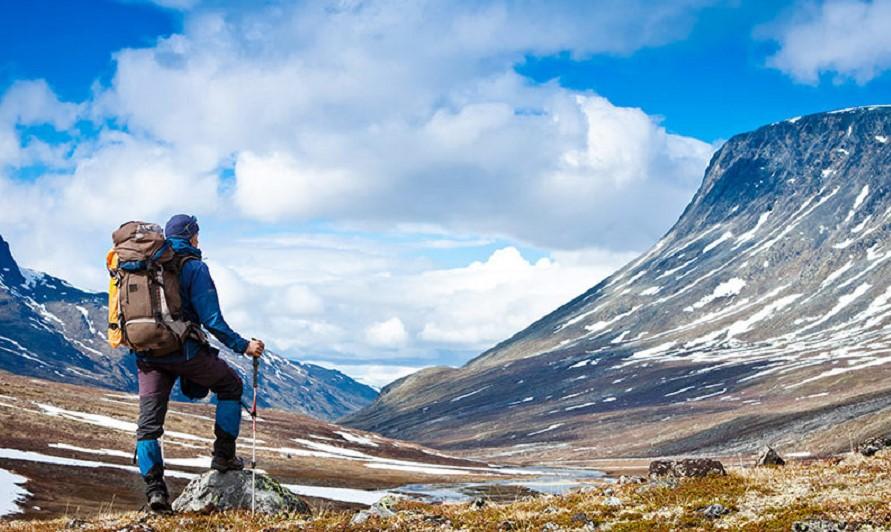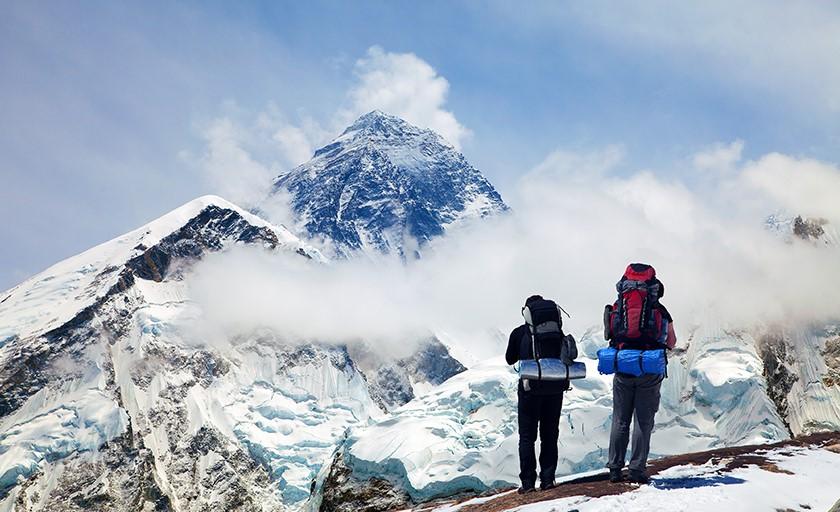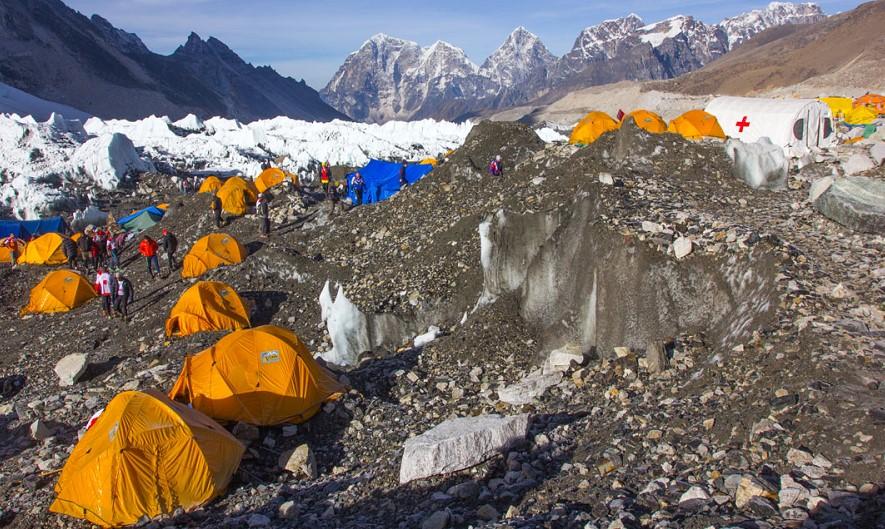The mountains call to us, beckoning us to come and explore their peaks and valleys, ridges, and gorges. For those of us drawn to the challenge of high altitude hiking and running, there are a few things to remember before embarking on this adventurous journey.
In this article, we will discuss how to train for high altitude hiking and running successfully, so that you can fully enjoy the beauty and thrill of mountain exploration.

- What is considered a high altitude for hiking?
- How to train for high altitude and low oxygen environments?
- Gradually increase your exposure to high-altitude
- Hike with a heavy pack
- How To Train For High Altitude Hiking
- Don’t forget weight training
- Hill training is stress-testing your body
- Altitude-adjusted training rooms
- Altitude tents
- Tips for avoiding altitude sickness (acute mountain sickness)
- Ascend slowly
- Hike high, sleep low
- Supplements and medications
- Popular high-altitude destinations for hiking and trekking
- FAQ
- How do you train to hike at high altitude?
- What is the fastest way to adjust to high altitude?
- How do you train your lungs for high altitude?
- Conclusion
What is considered a high altitude for hiking?
When we talk about how to train for high altitude hiking, we are typically referring to elevations above 8,000 feet, where the air is thin and the weather is extreme. At these heights, the air pressure is lower, which means that there is less oxygen available for your body to use.
This can make physical exertion much more complex, and can even be dangerous for those who are not properly prepared and cause high altitude pulmonary edema or high altitude cerebral edema.
When we’re at sea level, the air we breathe is comprised of about 21% oxygen.
As we move up in altitude, the air becomes less dense, meaning there are fewer oxygen molecules in each breath we take.
At 8,000 feet, the air contains only about 16% oxygen, and as we move higher, the oxygen levels can drop to as low as 10%. For someone who is not acclimatized to these lower oxygen levels, this can cause a host of problems, from mild headaches to severe sickness.
The effects of altitude can be especially challenging for those who are used to exercising at lower elevations. In addition to the reduced oxygen levels, the colder temperatures and harsh weather conditions can also take their toll on the body.
That’s why it’s essential to train properly for hiking and running, to help your body adjust to the lower oxygen levels, and to build up your strength and endurance.
By training appropriately, you can prepare your body to adapt to the lower oxygen levels and the harsh conditions that come with hiking and running.
With proper training, you can mitigate the effects of sickness, and improve your chances of having an enjoyable and rewarding experience in the mountains.
So, if you’re considering taking on the challenge of hiking or running, take the time to prepare, and make sure you’re equipped with the knowledge and tools you need to succeed.

How to train for high altitude and low oxygen environments?
Interval training can also be beneficial for improving lung capacity and oxygen uptake. One way to train your lungs for high altitude is through exercises like deep breathing, which can help prepare your body for the lower oxygen levels at a higher altitude.
You can also try using a specialized altitude training mask, which simulates the reduced oxygen levels of high altitudes during exercise. However, it’s important to note that this type of training should be approached with caution, as it can be risky and may not be suitable for everyone.
Gradually increase your exposure to high-altitude
If you’re planning a high altitude trek or run, it’s essential to understand the importance of acclimatization. When you’re higher above sea level, your body has to work harder to get the oxygen it needs, and this can be stressful on your cardiovascular system.
The best way to reduce the risk of altitude sickness and stress on the cardiovascular system is by acclimatizing properly and by interval training.
Acclimatization is allowing your body to gradually adjust to high altitude above sea level. This means starting your high-altitude trekking at lower elevations and progressively working your way up to higher elevations. This process can take several days, or even weeks, depending on how high you plan to climb.
During acclimatization, your body goes through several adaptations to compensate for the lower oxygen levels. These adaptations include increased respiration, the production of red blood cells, and the formation of new capillaries. These changes improve your body’s ability to deliver oxygen to your muscles and brain, which is crucial when you’re exerting yourself at above sea level.
Hike with a heavy pack
High altitude hiking is a challenging activity that requires a lot of strength and endurance. If you’re planning to hike at higher elevations, one of the best ways to prepare is by hiking with a heavy pack. This will help you build the strength and endurance you need to carry your gear and supplies at high elevations.
When you hike with a heavy pack, your body is forced to work harder, which helps to build strength and endurance.
This is especially important when you’re hiking at high elevations, where the air is thinner, and your body is already under increased stress.
By training with a heavy pack, you can increase your cardiovascular fitness, build endurance, and improve your overall fitness level, all of which are essential for high altitude hiking.
When you’re starting, it’s important, to begin with even a light pack and gradually increase the weight as you get stronger. This will help prevent injuries and allow your body to adjust to the added weight slowly.
You should also focus on maintaining good posture and using proper hiking techniques to avoid strain on your back and joints.

How To Train For High Altitude Hiking
In addition to hiking with a heavy pack, you should also incorporate other types of interval training into your routine. This might include cardio workouts and aerobic fitness like running, cycling, or swimming, as well as strength training exercises like squats, lunges, and deadlifts.
These exercises will help you build the strength and endurance you need to tackle high altitude hikes.
Don’t forget weight training
Training hikes with weight is an important part of preparing for high altitude hiking, as it helps to build up the muscles in your legs and core, which are essential for carrying a heavy pack over long distances.
Physical fitness also helps to improve your balance, stability, and overall endurance, all of which are important when hiking at high altitudes.
When it comes to strength training for high-altitude hiking, exercises that focus on your legs and core are particularly effective. Squats, lunges, and calf raises are great for building leg strength, while planks, bridges, and Russian twists can help to build core strength.
It’s important to gradually increase the intensity and duration of your weight training, just as you would with your cardio workouts. You should also give your body time to rest and recover between sessions, as overtraining can lead to injury or burnout.
Hill training is stress-testing your body
Hill training is an excellent way to stress test your body and build strength and endurance. Find a steep hill or set of stairs and do repeats, gradually increasing the number of repeats over time.
This will help build your cardiovascular endurance and leg strength, which will come in handy on high altitude hikes.

Altitude-adjusted training rooms
If you live in an area with limited access to high altitude hiking, it can be challenging to prepare for the reduced oxygen levels and challenging terrain that come with high-altitude hiking.
One solution to this challenge is to use an altitude adjusted training room, which can help you prepare for high-altitude hikes in a controlled environment.
Altitude adjusted training rooms use a special technology that simulates the reduced oxygen levels of high altitudes.
These rooms are typically equipped with a hypoxic air generator, which removes some of the oxygen from the air, creating an environment that simulates high altitude conditions.
By training in this environment, you can acclimate your body to the lower oxygen levels you will experience at a high altitude.
Altitude tents
Altitude tents are an innovative and popular option for those who want to prepare for high altitude hiking. These tents are designed to simulate high altitude environments by creating a low-oxygen atmosphere. They are an excellent option for individuals who want to acclimatize their bodies to a high altitude and ensure that they are ready for the physical demands of high-altitude hiking.
Tents work by reducing the amount of oxygen in the air you breathe while you sleepю
By using an altitude tent, you can create an environment that simulates high-altitude conditions, which can help your body adapt to the reduced oxygen levels that you’ll experience when hiking at high altitudes.
The tent is typically made of breathable materials and is designed to fit over your bed, allowing you to sleep in a low-oxygen environment.
While tents can be expensive, they are a great investment for those who are serious about hiking. They can help you prepare for the physical and mental challenges of high-altitude environments, and can also help you avoid altitude sickness.
By acclimatizing your body to the low-oxygen environment, you’ll be better able to handle the physical demands of high altitude hiking, which can include steep climbs, rocky terrain, and unpredictable weather conditions.

Tips for avoiding altitude sickness (acute mountain sickness)
Ascend slowly
Ascending slowly is one of the most important things you can do to avoid developing altitude sickness. Altitude sickness, also known as acute mountain sickness, is a common condition that can occur when you travel to high altitudes too quickly. Symptoms of altitude sickness can range from mild to severe and can include headaches, nausea, fatigue, dizziness, and difficulty sleeping.
To prevent mountain sickness, it’s important to give your body enough time to acclimate to the lower oxygen levels that you’ll encounter at higher altitudes. This means ascending slowly and taking frequent breaks. For example, if you’re hiking to a destination, you might plan to spend a night at a lower altitude on your way up to help your body adjust.
Hike high, sleep low
Sleeping at a lower elevation than you hiked during the day is a common technique used by many hikers to help prevent altitude sickness. This strategy is known as “hike high, sleep low,” and it involves hiking to a higher elevation during the day but sleeping at a lower elevation at night.
The idea behind this strategy is that hiking to higher elevations during the day will help your body acclimate to the lower oxygen levels while sleeping at a lower elevation at night will give your body a chance to recover and adjust. By doing this, you can slowly increase your exposure to high altitudes without putting your body at risk of altitude sickness.

Supplements and medications
While gradual acclimatization and proper hydration are the best ways to prevent altitude sickness, there are some medications and supplements that can also help reduce your risk of experiencing altitude sickness. These include both over-the-counter remedies and prescription medications.
Over-the-counter medications such as ibuprofen or aspirin can help alleviate symptoms like headaches and muscle aches, which are common at high altitudes. However, it’s important to note that these medications won’t prevent altitude sickness, they just help to alleviate some of the symptoms.
Prescription medications like Diamox can be effective in preventing sickness, especially for those who are particularly susceptible to it. Diamox works by reducing the amount of bicarbonate in your blood, which in turn helps to increase your body’s respiratory rate and eliminate excess carbon dioxide. This can help your body acclimate more quickly.
It’s important to talk to your doctor before taking any new medications, especially if you have any preexisting medical conditions. Your doctor can advise you on the best course of action based on your health status and the specific conditions you may encounter on your high-altitude hike.
In addition to medications, several natural supplements can help prevent altitude sickness.
Again, it’s important to talk to your doctor before taking any new supplements to ensure they are safe for you to use.
Popular high-altitude destinations for hiking and trekking
Now that you know how to prepare for high altitude hiking and running, you might be wondering where to go to test your skills. Here are a few popular destinations for mountain climbing and trekking:
Mount Kilimanjaro, Tanzania is 19,341 feet above sea level. This is the mountain with the maximum altitude in Africa and a popular destination for hikers and trekkers.
The Inca Trail, Peru. This ancient trail takes hikers through the Andes Mountains and up to the historic ruins of Machu Picchu.
Everest Base Camp, Nepal. While only a fraction of hikers make it to the summit of Mount Everest, many people go to high altitude trek to base camp, which is still an impressive 17,600 feet above sea level.
If you train for high altitude hiking and running, it can be an incredible and rewarding experience. So get out there, take on the mountains, and make memories that will last a lifetime.

FAQ
How do you train to hike at high altitude?
Training for high altitude hiking involves gradually exposing your body to lower levels of oxygen by hiking or running at higher elevations.
Starting with lower elevation hikes and gradually working your way up to higher altitudes can help your body acclimate to the reduced oxygen levels. Building strength and endurance through exercises like hill training and weight training can also help prepare your body for high-altitude hikes.
What is the fastest way to adjust to high altitude?
There is no fast way to adjust to high altitude, as acclimatization takes time.
However, there are a few strategies that can help speed up the process, such as ascending slowly, staying hydrated, avoiding alcohol and caffeine, and taking medication like Diamox or other supplements that can help alleviate symptoms of altitude sickness.
How do you train your lungs for high altitude?
To train your lungs for high altitude, it’s recommended to do exercises that strengthen your respiratory muscles, such as diaphragmatic breathing exercises, which help increase your lung capacity and improve the delivery of oxygen to your body.
Another effective way to train your lungs is through cardio exercises like running, cycling, or swimming, which help improve your overall fitness and endurance. Using an altitude-adjusted training room or altitude tent can also help your body adapt to lower oxygen levels at high altitudes.
Conclusion
Preparing for a high altitude hiking or running adventure can be both exhilarating and daunting. However, with proper training, acclimatization and preparation, you can enjoy the breathtaking views and thrilling experiences that high altitude hikes and runs have to offer.
Gradual exposure to higher altitudes, strength and endurance training, and supplement or medication support can help train for high altitude.
Remember to take it slow, stay hydrated, and listen to your body. With these tips and a little determination, you’ll be well on your way to a successful hike or run in some of the world’s most stunning locations.
Read More: 7 Tips For High Altitude Hiking



![What is considered a long hike? [8 factors to consider] What Is Considered A Long Hike: Top 3 Tips & Best Guide](https://griffithparkhiker.com/wp-content/uploads/2024/01/griffithparkhiker-2-335x220.jpg)





